Just MTF Charts
Just MTF Charts: Sony FE Mount Prime Lenses

This is the fourth post publishing all of our MTF results so that methodology is consistent and they are easy to find. The previous have been by lens brand. This one is by the mount, since the Zeiss Batis and Loxia lenses fit more naturally here than with the Zeiss SLR lenses. Otherwise, no comparisons, no commentary, just the test results for you to use and abuse as you see fit.
Oh, wait. One commentary. You’ll notice the Sony 28mm f/2 lens does not have 20mm results, it stops at 18mm. This lens has a small amount of copy-to-copy variation of distortion that makes the very edge results of our automated testing seem to have more variation than is real. Faced with the option of presenting questionable results or testing 10 copies by hand, I voted to just not present that data. I do want to emphasize this a technical testing issue, not something that would affect photography.
With that out of the way, here are the Sony FE mount prime lenses, followed by the Zeiss Batis and Loxia lenses. (The Sony FE 24mm f1.4 and Sony FE 35mm f1.8 have been recently added.)
A Quick How to on Reading MTF ChartsIf you’re new here, you’ll see we have a scientific methodology to our approach, and use MTF charts to measure lens resolution and sharpness. All of our MTF charts test ten of the same lenses, and then we average out the results. MTF (or (or Modulation Transfer Function) Charts measure the optical potential of a lens by plotting the contrast and resolution of the lens from the center to the outer corners of the frame. An MTF chart has two axis, the y-axis (vertical) and the x-axis (horizontal). The y-axis (vertical) measures how accurately the lens reproduces the object (sharpness), where 1.0 would be the theoretical “perfect lens”. The x-axis (horizontal) measures the distance from the center of a lens to the edges (measured in millimeters where 0mm represents the center, and 20mm represents the corner point). Generally, a lens has the greatest theoretical sharpness in the center, with the sharpness being reduced in the corners. Tangential & Sagittal LinesThe graph then plots two sets of five different ranges. These sets are broken down into Tangential lines (solid lines on our graphs) and Sagittal (dotted lines on our graphs). Sagittal lines are a pattern where the lines are oriented parallel to a line through the center of the image. Tangential (or Meridonial) lines are tested where the lines are aligned perpendicular to a line through the center of the image. From there, the Sagittal and Tangential tests are done in 5 sets, started at 10 lines per millimeter (lp/mm), all the way up to 50 lines per millimeter (lp/mm). To put this in layman’s terms, the higher lp/mm measure how well the lens resolves fine detail. So, higher MTF is better than lower, and less separation of the sagittal and tangential lines are better than a lot of separation. Please keep in mind this is a simple introduction to MTF charts, for a more scientific explanation, feel free to read this article. |
Sony FE Prime Lenses
Sony FE 24mm f/1.4 GM

Lensrentals.com, 2019
Sony FE 28mm f/2
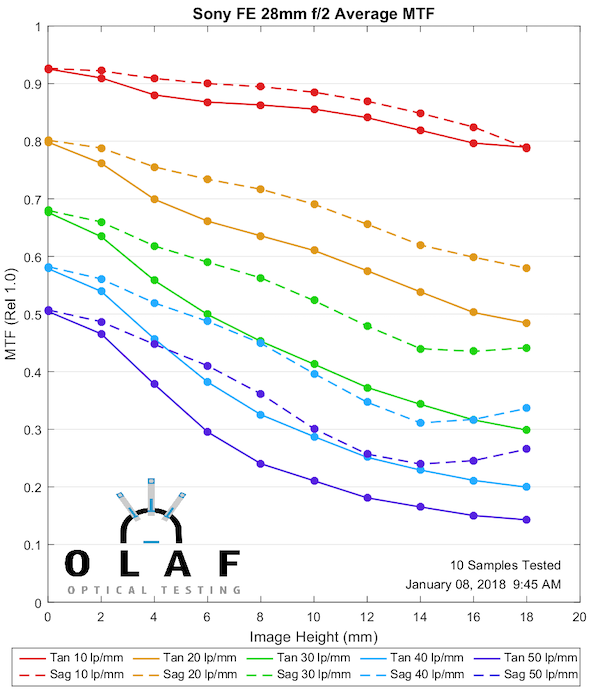
Lensrentals.com, 2019
Sony FE Sonnar 35mm f/2.8
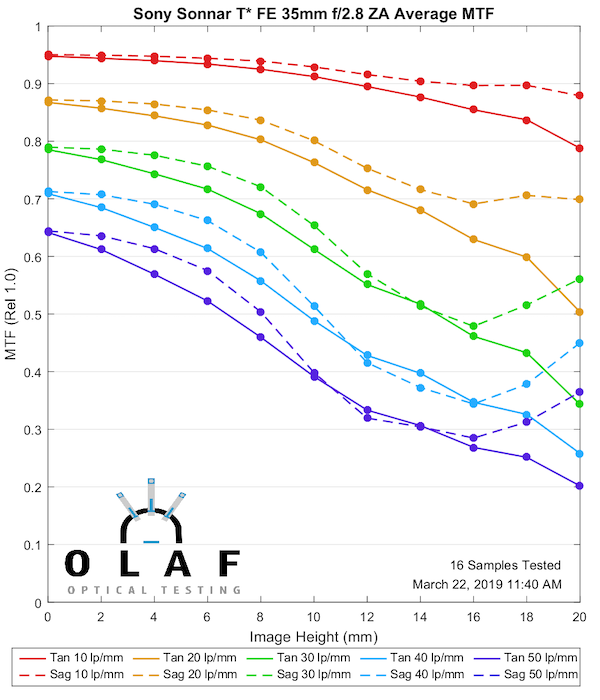
Lensrentals.com, 2019
Sony FE Distagon T 35mm f1.4 ZA

Lensrentals.com, 2019
Sony FE 35mm f1.8

Lensrentals.com, 2019
Sony FE Planar 50mm f1.4 ZA

Lensrentals.com, 2019
Sony FE 50mm f1.8
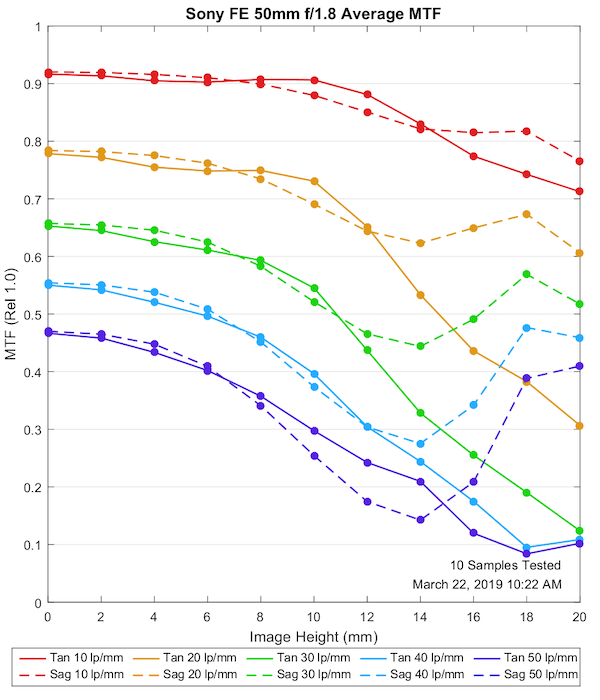
Lensrentals.com, 2019
Sony FE Sonnar T 55mm f1.8 ZA
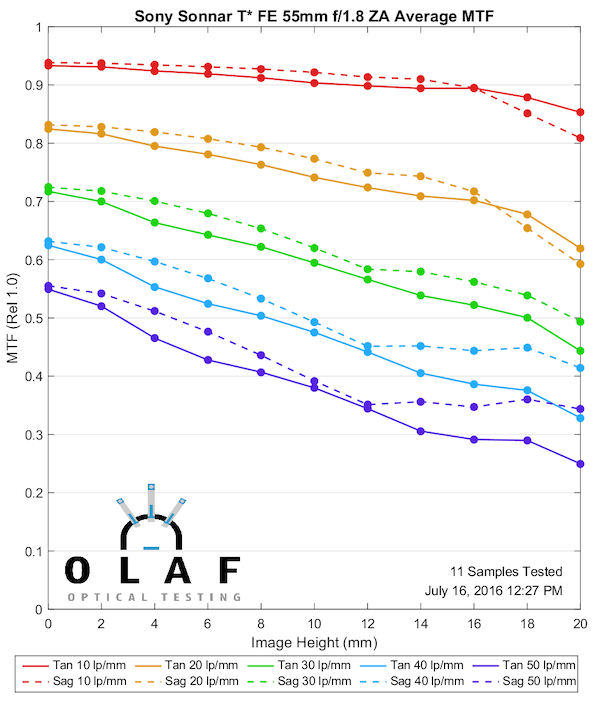
Lensrentals.com, 2019
Sony FE 85mm F1.4 GM

Lensrentals.com, 2019
Sony FE 85mm f1.8
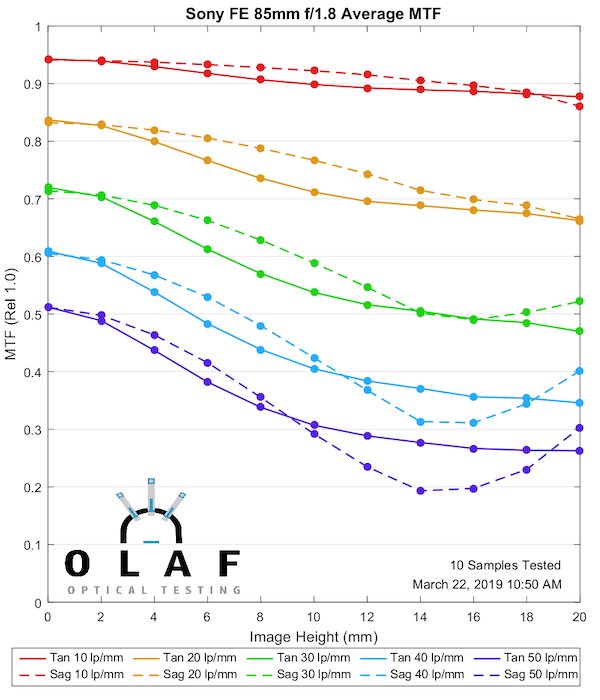
Lensrentals.com, 2019
Sony FE 90mm f/2.8 Macro G OSS

Lensrentals.com, 2019
Sony FE 135mm f/1.8 GM

Lensrentals.com, 2019
Zeiss FE-Mount Lenses
Batis
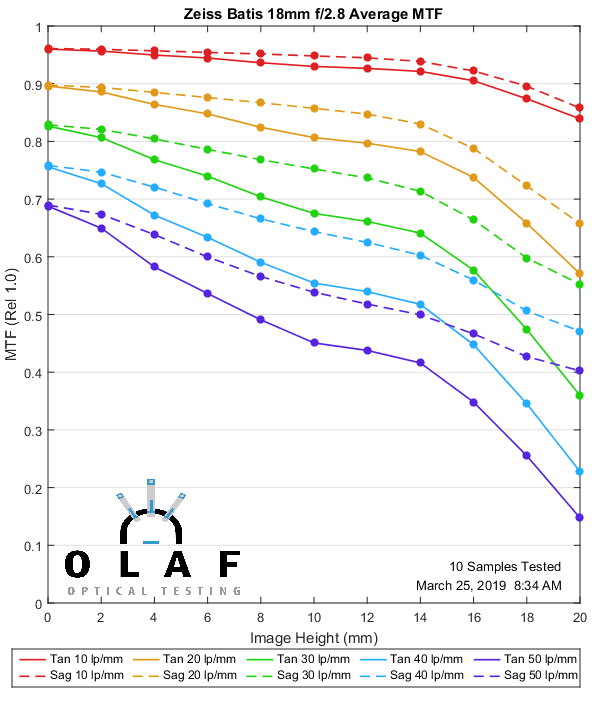
Lensrentals.com, 2019

Lensrentals.com, 2019

Lensrentals.com, 2019

Lensrentals.com, 2019
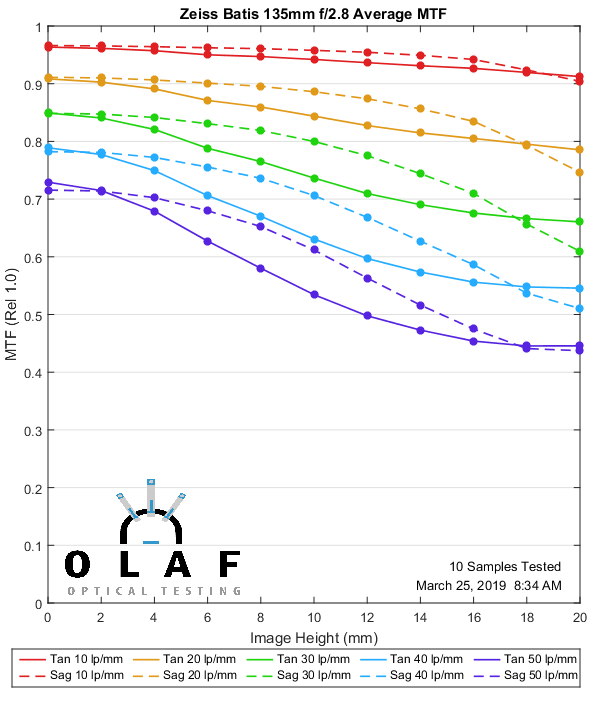
Lensrentals.com, 2019
Loxia

Lensrentals.com, 2019
Note: this is data from only 3 copies. I have no excuses. I was lazy, the lens didn’t interest me much when it first came out, and I never went back and completed the testing.
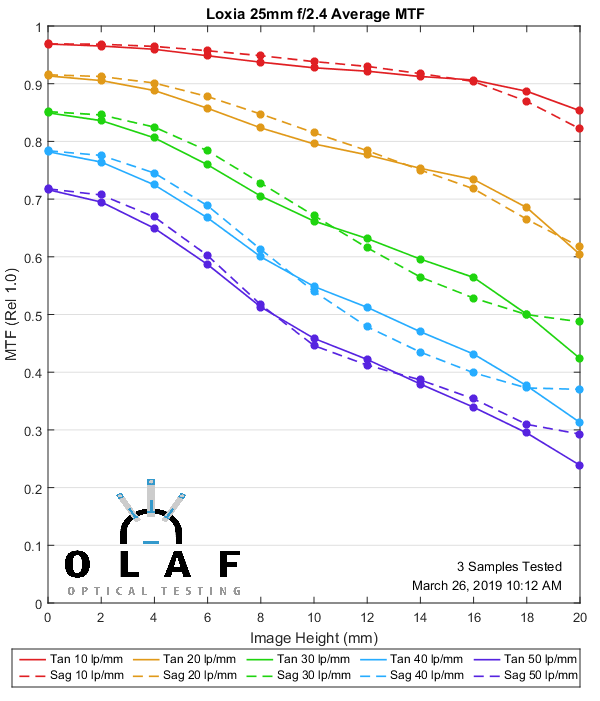
Lensrentals.com, 2019

Lensrentals.com, 2019

Lensrentals.com, 2019

Lensrentals.com, 2019
For a look at all the Just MTF Articles we’ve done so far, be sure to check them out here.
Roger Cicala, Aaron Closz, and Brandon Dube
Lensrentals.com
March, 2019
Author: Roger Cicala
I’m Roger and I am the founder of Lensrentals.com. Hailed as one of the optic nerds here, I enjoy shooting collimated light through 30X microscope objectives in my spare time. When I do take real pictures I like using something different: a Medium format, or Pentax K1, or a Sony RX1R.
-
Moyang
-
Wes Perrault
-
Ash
-
Hubert Baierl
-
Hubert Baierl
-
Mike Aubrey
-
Roger Cicala
-
Tae Kub
-
Leo
-
CheshireCat
-
Max Manzan
-
frankthp
-
Roger Cicala

